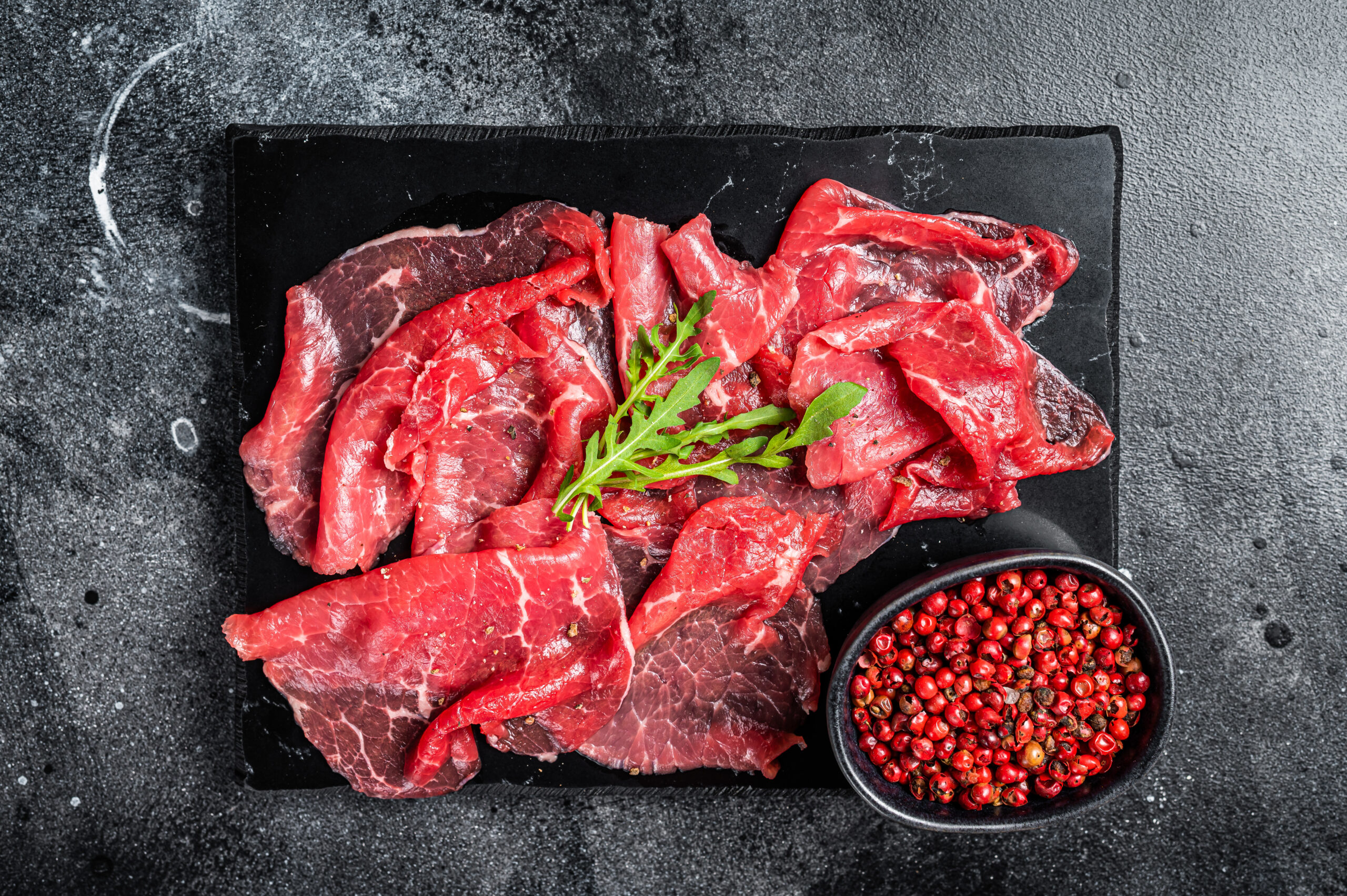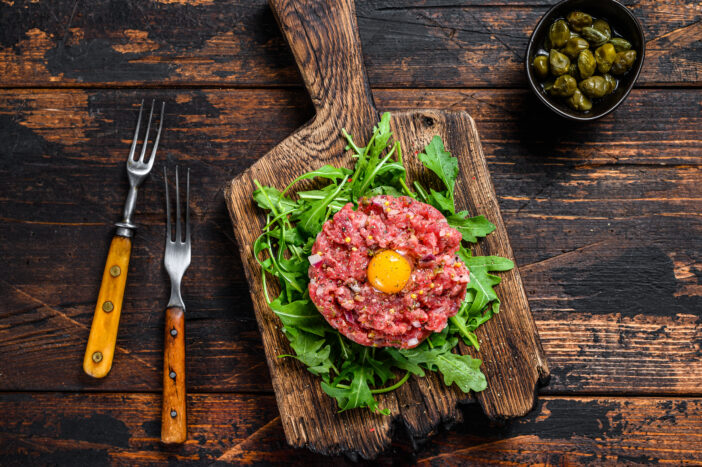5 Differences Between Beef Carpaccio vs Beef Tartare for Perfect Dining
Beef carpaccio offers thin, raw slices with subtle flavors, while tartare features finely chopped beef mixed with bold seasonings for a rich taste experience.

You’re at a dinner party and the menu features beef carpaccio and tartare, leaving you intrigued but slightly bewildered. Let’s dive into the art of serving these sophisticated dishes, ensuring you can savor them like a seasoned gourmet.
Disclosure: As an Amazon Associate, this site earns from qualifying purchases. Thank you!
Key Differences Between Beef Carpaccio and Tartare

Delve into the nuances of beef carpaccio and tartare: two gourmet dishes that might look somewhat similar but are distinct in preparation and taste.
Texture and Preparation
- Beef Carpaccio: Carpaccio features thinly sliced raw beef, usually drizzled with olive oil, and lemon, and topped with capers or onions. The key is thin slicing, which demands a sharp knife and a skilled hand. It’s often served chilled, enhancing its delicate texture.
- Beef Tartare: Tartare, on the other hand, involves finely chopped or minced raw beef. It’s mixed thoroughly with ingredients like onions, capers, and often an egg yolk. The preparation creates a more cohesive and slightly textured dish usually served at room temperature, providing a richer mouthfeel.
Flavor Profiles
- Beef Carpaccio: Carpaccio’s flavor is subtle, leaning heavily on the natural, mild taste of the raw beef enhanced by the acidity from lemon and the bite from capers or onions. This dish allows the quality of the meat to shine, complemented by its toppings.
- Beef Tartare: Tartare offers a bolder experience with a robust mix of flavors, thanks to the additional ingredients. The inclusion of condiments and sometimes spices or herbs integrates deeply with the meat, creating a complex taste profile that can vary widely depending on the recipe.
Selecting the Best Cuts of Beef for Carpaccio and Tartare

When it comes to preparing exquisite dishes like beef carpaccio and tartare, choosing the right cut of beef is essential. Here’s a guide to the best cuts for each dish to ensure the perfect texture and flavor.
Recommended Cuts for Beef Carpaccio
- Eye of Round: This lean cut from the hindquarters delivers a fine grain and robust flavor, ideal for thin slicing.
- Sirloin: Offers a balanced mix of flavor and tenderness, making it a versatile choice for carpaccio.
- Tenderloin: Known for its buttery texture, this premium cut allows for ultra-thin slices that melt in your mouth.
Recommended Cuts for Beef Tartare
- Top Round: Lean yet flavorful, it’s finely chopped to blend well with tartare’s bold seasonings.
- Chuck: Provides a richer flavor due to the higher fat content, enhancing the depth of your tartare.
- Sirloin: Again, a great choice for its tender texture and ability to absorb the seasoning, giving a well-rounded flavor profile to your dish.
Essential Tips for Preparing Beef Carpaccio

After selecting the perfect cut of beef, mastering the carpaccio’s preparation enhances its refined flavors. Dive into these essential techniques to ensure your beef carpaccio stands out with sophistication and taste.
Handling and Slicing Techniques
- Freeze the Beef: Briefly freeze the meat to firm it up, making slicing easier. Around 30-60 minutes should suffice depending on the thickness.
- Use a Sharp Knife: A very sharp chef’s knife or a slicing knife ensures clean, thin slices that are almost translucent.
- Slice Against the Grain: Look at the direction of the muscle fibers and slice perpendicular to them. This technique ensures the beef is tender rather than chewy.
- Maintain Uniform Thickness: Aim for consistently thin slices, about 1-2 mm thick, to guarantee that each bite is delicate and melts in your mouth.
Enhancing Flavor
- Keep it Simple: Olive oil, salt, and a squeeze of fresh lemon juice blend beautifully without overpowering the natural flavors of the beef. Add a dash right before serving to maintain freshness.
- Use High-Quality Olive Oil: The olive oil’s richness complements the lean meat, so opt for extra-virgin olive oil for the best taste and aroma.
- Marinate Minimally: If you choose to marinate, keep it minimal to enhance rather than mask the meat’s natural flavor. A brief marination of 30 minutes in the refrigerator with minimal ingredients is optimal.
- Incorporate Fresh Herbs: Adding fresh herbs like basil or parsley can introduce a subtle freshness that elevates the overall dish without dominating the flavor profile.
Essential Tips for Preparing Tartare

Transitioning from beef carpaccio, it’s time to focus on mastering beef tartare. This section offers you key insights into handling and preparing tartare with precision and flavor.
Handling and Chopping Techniques
- Select Fresh Meat: Opt for high-quality, fresh beef like sirloin or tenderloin. Ensure it’s from a reputable source to guarantee safety and flavor.
- Use Sharp Knives: A sharp chef’s knife is crucial for finely chopping beef without bruising it. Keep your knives well-maintained to make precise cuts.
- Maintain Cool Temperatures: Keep the beef chilled until you’re ready to chop. This helps in cutting cleanly and maintaining the meat’s integrity.
- Chop Evenly: Aim for consistent, small dice to ensure even seasoning and texture in every bite. Uniform pieces blend flavors more effectively.
Enhancing Flavor
- Incorporate Ingredients Gently: Mix in seasonings like minced onions, capers, fresh herbs, and a touch of Dijon mustard gently to avoid crushing the beef.
- Balance the Flavors: Season with salt and freshly ground black pepper to taste. Remember, it’s about enhancing the beef’s natural flavors, not overpowering them.
- Consider an Egg Yolk: For a traditional touch, gently mix in a raw egg yolk just before serving. It adds richness and binds the ingredients slightly.
- Taste and Adjust: Always taste your tartare before serving to ensure the balance of flavors is just right. Adjust seasoning if necessary to achieve the perfect taste.
Best Serving Practices for Beef Carpaccio

When it comes to the fine dining experience of beef carpaccio, how you serve it can enhance both its flavors and visual appeal. Here’s how to make sure every detail stands out.
Ideal Accompaniments
Pair your beef carpaccio with simple, high-quality ingredients to let the delicate flavor of the meat shine:
- Olive Oil: Use extra virgin olive oil for a fruity, peppery note.
- Cheese: Thin shavings of Parmesan or pecorino add a salty, nutty touch.
- Arugula: Its peppery leaves complement the meat’s mild taste.
- Bread: Serve with slices of fresh, crusty bread like baguettes or ciabatta.
- Lemon Wedges: A squeeze adds a fresh, bright flavor, cutting through the richness of the meat.
Presentation Tips
The visual presentation of beef carpaccio is almost as crucial as its taste:
- Plate Choice: Use a chilled, white plate to enhance the meat’s vibrant red color.
- Arrangement: Lay slices slightly overlapping in a circular or spiral pattern for elegance.
- Garnishes: Add color and texture with small capers, minced chives, or microgreens.
- Drizzling: Finish with a graceful drizzle of olive oil and maybe some balsamic reduction for a touch of sweetness.
- Seasoning: A final sprinkle of coarse salt and freshly ground pepper just before serving adds a punch of flavor and texture.
By following these serving tips, you’ll ensure that your beef carpaccio not only tastes exquisite but also looks stunning on the plate.
Best Serving Practices for Tartare

After delving into the unique preparations of tartare, it’s crucial to focus on the best ways to serve this exquisite dish. The right accompaniments and presentation enhance the dining experience, making each bite memorable.
Ideal Accompaniments
- Choose Fresh Herbs: Incorporate fresh herbs like parsley or chives for a burst of freshness that compliments the rich taste of the beef.
- Opt for Crusty Bread: Serve with slices of crusty baguette or rye bread toasted lightly to add texture.
- Include Sharp Flavors: Accompany with capers, pickles, or mustard to introduce sharpness that balances the meat’s richness.
- Add Creaminess: Consider a dollop of high-quality mayonnaise or raw egg yolk on top for a creamy texture that melds beautifully with the chopped beef.
Presentation Tips
- Use a Cold Plate: Serve tartare on a cold plate to keep the meat fresh and enhance its flavors.
- Maintain Minimalism: Arrange the tartare neatly in the center, using a ring mold for a professional look, keeping the presentation simple and elegant.
- Garnish Wisely: Garnish with microgreens or edible flowers for a pop of color and a subtle hint of flavor.
- Season Properly: A light sprinkling of sea salt and freshly ground pepper just before serving can elevate the flavor profile significantly.
Health and Safety Considerations
When it comes to enjoying beef carpaccio and tartare, ensuring the meat’s safety is paramount. Read on for critical insights into selecting and handling beef meant to be served raw.
- Source Credibly: Always purchase beef from reputable suppliers who guarantee fresh, high-quality, and traceable products.
- Look for Labels: Opt for beef that’s specifically marked as safe for raw consumption, such as “sashimi-grade” or similar certifications.
- Check Freshness: Evaluate the freshness by checking the color — fresh beef should be a vibrant red with a clean smell.
- Maintain Cold Temperature: Keep beef at or below 40°F by storing it in the refrigerator or a properly insulated area until ready to prepare.
- Avoid Cross-Contamination: Use separate cutting boards and knives for raw beef and other foods. Always wash your hands, utensils, and work surfaces after they come in contact with raw meat.
- Use Quickly: Consume raw beef dishes within 24 hours of preparation to minimize the risk of bacterial growth and contamination.
Frequently Asked Questions
What are the main differences between beef carpaccio and beef tartare?
Beef carpaccio is typically served as thin, raw slices of beef, accentuating its natural flavors, while beef tartare is finely chopped or ground and mixed with various ingredients like onions, capers, and seasonings to enhance its taste.
How should I select the best cut of beef for carpaccio?
For carpaccio, opt for high-quality, lean cuts such as sirloin, tenderloin, or top round. The meat should be fresh and have minimal marbling to ensure tender, flavorful slices.
What is important to consider when preparing beef tartare?
When preparing beef tartare, it’s crucial to select the freshest beef possible, typically tenderloin, and ensure it is finely chopped. Balance the flavors with the right amount of seasonings, like salt, pepper, and herbs, and include add-ins like onions or capers for extra texture and taste.
What are the key safety tips for serving raw beef dishes?
Ensure you source your beef from reputable suppliers, maintain the meat at cold temperatures, and follow stringent hygiene practices to prevent cross-contamination. Consume raw beef dishes like carpaccio and tartare within 24 hours to maintain freshness and safety.
How can I ensure the beef for carpaccio is sliced properly?
To achieve the ideal thinness for carpaccio, partially freeze the beef to firm it up, making slicing easier. Use a sharp, thin-bladed knife or a meat slicer for even, delicate slices.
Is it safe to serve raw beef at a dinner party?
Serving raw beef like carpaccio and tartare can be safe if handled correctly. Always use fresh meat, keep it chilled, minimize the time it’s at room temperature, and adhere to strict kitchen hygiene to reduce the risk of foodborne illnesses.






